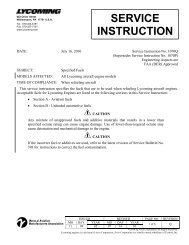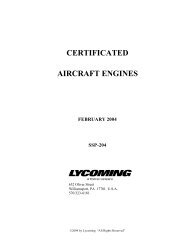Create successful ePaper yourself
Turn your PDF publications into a flip-book with our unique Google optimized e-Paper software.
and Non-Certified Engines through most if not all Experimental<br />
OEMs. Since these manufacturers designed the aircraft, they are<br />
well equipped to handle your powerplant questions and needs.<br />
<strong>Lycoming</strong> has recently launched Thunderbolt Engines. This is<br />
where technology and passion meet. Only the most premium<br />
engines carry the Thunderbolt Engine Medallion. These engines<br />
will be custom-built to your specifications from horsepower to<br />
engine color and everything in between at <strong>Lycoming</strong>’s performance-proven<br />
facility in Williamsport, PA. It’s one-of-a-kind<br />
pairing of <strong>Lycoming</strong> reliability and cutting-edge technology for<br />
the kind of power and status only the most passionate ever attain.<br />
Please contact Thunderbolt Engines at 570-327-7115 to exercise<br />
your “Power of Choice.”<br />
<strong>Lycoming</strong> has also launched an impressive lineup of engine kits<br />
that are available through an exclusive network of internationally<br />
recognized shops. These engines will be assembled from<br />
100% <strong>Lycoming</strong> parts and tested before delivery. Through this<br />
exclusive network, <strong>Lycoming</strong>’s Kit Engine product line delivers<br />
the power plant solutions that experimental aircraft builders have<br />
been asking for.<br />
For more facts on the power of making the right choice, please<br />
visit us at www.lycoming.textron.com.<br />
Reading the “Aircraft for Sale” advertisements can be interesting<br />
and misleading. As aviation-oriented people, we are conditioned<br />
to look for certain bits of information which we believe will<br />
allow us to evaluate the product offered for sale. In the case of<br />
airplanes, this information can generally be segregated into three<br />
categories — airframe, avionics and engine. For purposes of this<br />
article, you are on your own with respect to airframe and avionics.<br />
There does seem to be information on engines which cannot be<br />
emphasized too strongly.<br />
Engine information is usually provided as hours of operation<br />
since new or from some major maintenance event. For example,<br />
700 TTSN would indicate that this aircraft and engine have<br />
been flown for 700 hours since new from the factory. Other,<br />
but not all, engine-related abbreviations include SMOH (hours<br />
since major overhaul, SPOH (hours since prop overhaul), STOH<br />
(hours since top overhaul) and SFRM (hours since factory<br />
remanufacture). Assuming that the recommended TBO of the<br />
engine being considered is 1800 or 2000 hours, it would appear<br />
that hours of use in the 400- to 800-hour range would automatically<br />
make this engine a very valuable commodity. Unfortunately<br />
this is not always true, and therefore an advertisement like those<br />
discussed earlier may state numbers and facts which are absolutely<br />
correct, but still misleading.<br />
Consider a situation which occurred recently. A <strong>Lycoming</strong><br />
IO-360 engine with less than 700 hours since new was reported to<br />
be using oil at the rate of two-thirds quart per hour and losing oil<br />
pressure during flight. On closer examination, it was determined<br />
0 L y c o m i n g F l y e r<br />
that deterioration and wear had caused metal contamination<br />
throughout the engine. An engine overhaul was necessary, and<br />
it included replacement of items such as the camshaft, oil pump<br />
gears and pistons. Why should an engine with less than 700 hours<br />
since new be in this sad state?<br />
It should be apparent that the number of hours the engine has<br />
operated is only part of the story. We need to know all the facts<br />
if we are to understand what may have happened to this normally<br />
reliable engine, and also if we are to determine the value of a<br />
low-time engine in a preowned airplane.<br />
The engine with metal contamination and less than 700<br />
hours of operation had been installed brand new from the<br />
factory — more than 12 years before. The engine logbook<br />
shows that during the first 10 years of service, this engine had<br />
averaged less than four hours of flight time each month. Chances<br />
are excellent that there were some months when the engine was<br />
not flown at all.<br />
<strong>Lycoming</strong> Service Instruction No. 1009 states that the recommended<br />
TBO is based on the use of genuine <strong>Lycoming</strong><br />
parts, average experience in operation and continuous service.<br />
Continuous service assumes that the aircraft will not be out of<br />
service for any extended period of time. If an engine is to be out<br />
of service for longer than 30 days, it should be preserved as specified<br />
in <strong>Lycoming</strong> Service Letter No. L180. Service Instruction<br />
No. 1009 also states that because of the variations in operation<br />
and maintenance, there can be no assurance that an individual<br />
operator will achieve the recommended TBO.<br />
The point of this discussion is simple. A low-time engine may<br />
not add value to an aircraft, and the buyer should be aware of all<br />
factors which may affect the condition and value of the engine. An<br />
engine which is not flown frequently is subject to deterioration as<br />
a result inactivity. When the engine does not achieve flight operating<br />
temperatures on a regular basis, the moisture and acids that<br />
form as a result of combustion and condensation are not vaporized<br />
and eliminated through the exhaust and crankcase breather. As<br />
moisture and acids collect in the engine, they contribute to the<br />
formation of rust on the cylinder walls, camshaft and tappets.<br />
As the engine is run after rust has formed, the rust becomes a<br />
very fine abrasive causing internal engine wear, particularly to<br />
the camshaft and tappets. As these components wear, they make<br />
more metal which attacks the softer metals in the engine. Piston<br />
pin plugs are examples of parts that may wear rapidly when rust<br />
becomes an abrasive inside the engine. This wear could eventually<br />
lead to failure.<br />
The infrequently flown engine is just one example of a lowtime<br />
engine not meeting the expectations of a buyer or new<br />
owner. The term zero SMOH is always enticing since it indicates<br />
the engine has been overhauled, has zero hours since overhaul<br />
and now may be expected to fly happily on through a full<br />
manufacturer-recommended TBO. This will happen in some<br />
cases, but in others, there will not be a chance of this happening.<br />
It depends on the quality of the overhaul.<br />
<strong>Lycoming</strong> Service Bulletin No. 240 recommends parts to be<br />
replaced at overhaul regardless of the apparent condition of the<br />
old parts. The number of these new parts used in the engine at







